Wonders of recycling blood!
By Shanika Sriyananda
[email protected]
|
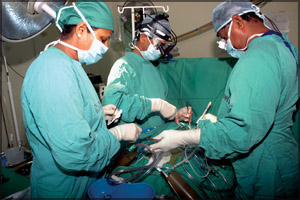
The team of surgeons at work during a by-pass using the
patient’s own blood.
|
|
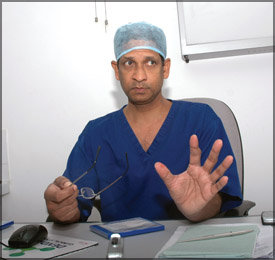
Dr. Y. M. K. Lahie, the Resident Consultant Cardiac Thoracic
Surgeon.
|
Imagine her heart beats and lungs move while she is in deep
‘slumber’. Medically, though the heart is ‘drowned’ in blood, her heart
throbs. The fifty-six year old patient is not supported by a machine
that keeps her two vital organs moving.
While the small, but miraculous ‘turbine’ - the heart- is still in
full swing, the cardiac surgeons are busy in a three-hour surgery to
correct the blocks - two on the left: the left arteria descending
artillery and circumflex artillery and the right coronary artillery -
which will cease the patients heart soon if not corrected soon.
Well, its yet another ‘by-pass’ surgery which is one of the most
known heart operations, like ‘koththamalli’ for common cold, in Sri
Lanka.
For Dr. Y. M. K. Lahie, the Resident Consultant Cardiac Thoracic
Surgeon at Nawaloka and his team, it is yet another heart operation. But
for us it is the first time, as Dr. Lahie says, that a media coverage is
allowed at this ‘beating heart’ surgery.
By-passes nature too
|
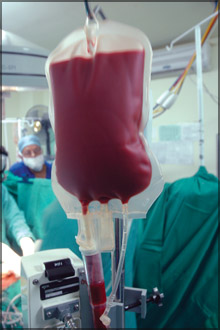
The blood bag that pumps the blood to the patient’s heart. |
It is not only by-passing the heart, but a moment which by-passes
nature too. It is a surgery where a drop of blood is not drained into
the sink and recycled during the surgery.
For decades, in the traditional coronary by-pass procedure, the
patient’s heart is stopped and blood flow and breathing are regulated by
a heart lung machine.
But with the modern discoveries in the field of heart surgery, using
off-pump by-pass, or operating on a beating heart, the experts say it
will prevent patients from suffering the cognitive decline that is often
associated with traditional by-pass surgery.
“Octopus please”, says Dr. Lahie explaining the importance of using
the patient’s own blood to prevent the risks involved in bank blood;
though it is safe; and also to avoid other complications that might
trigger when outside blood is pumped.
The octopus is a gadget which stabilizes the portion of the heart
during surgery and as it does not move the surgeons find it easy to put
sutures.
“We are doing this surgery without a heart-lung machine which is also
another advantage for the patient as it will damage the blood. During a
heart surgery or any other surgery there is a blood loss. And also when
we use this machine the blood gets diluted and blood is lost.
Here we save the blood and also minimise the bio-chemical changes”,
elaborates Dr. Lahie showing the ‘reservoir’ where the blood during the
surgery is collected, purified and transfused during or at the end of
the surgery.
Sister Renuka is giving some drugs from the line through the neck and
also getting blood from the patient through radial arterial to do some
blood tests.
Lasts a lifetime
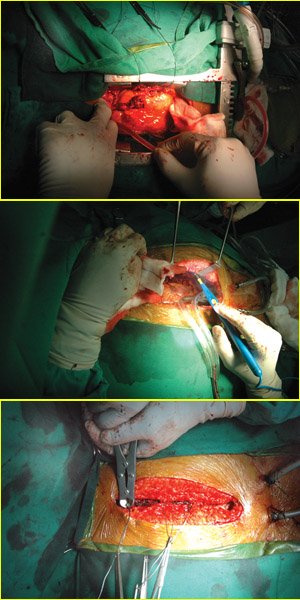 |
|
The heart in view during
stages of the by-pass. |
“Here, we use patients own artilleries and veins and avoid using any
foreign material to do the surgery. The advantage is we can do a
complete graft and correct whatever the blocks are”, Dr. Lahie further
explains as he cuts through the inner covering of the heart, the peri
cardium and finds the mammary artillery, which according to the surgeon,
is worth millions and cannot be purchased from anywhere.
“It will last a lifetime. It is the best graft for the coronary heart
surgeries and better than all the stances that man has ever discovered.
This is god’s gift to mankind. It has a tremendous blood flow”, marvels
Dr. P. Kamalaneshan, the Assistant Surgeon.
“We are not ready to by pass the blocks and restore the blood supply
to the heart. Check the pressure”, directs Dr. Lahie and digging into
the ‘compartment’ in search of the heart. Here is the beating heart and
he says that some have misunderstandings that the heart will be taken
out to do the by-pass. “It’s a myth and no where in the world is a
by-pass done taking the whole heart out”, the medical artists at the job
tells us.
Minute
The surgeons need to master the job using chopsticks too. In that
eight-inch opening where the heart is beating and lungs are moving the
two surgeons are ‘playing’ finely with the surgical equipment avoiding
even the slightest damage to the heart. One tiny extra cut will bring a
disaster. They start grafting the mammary artillery to the left interior
descending artillery which is the main artillery of the heart.
Who decides the type of surgery, it is the surgeon or the patient?
“The surgeon will decide whether it is a beating heart operation or
otherwise depending on the situation of the patient. This patient’s
blood group is O negative and very difficult to get in quantity. So here
it is a good technique, recycling the blood”, replies Dr. Lahie.
The fingers move rhythmically putting sutures to the tiny 5
millimetre cut in the artillery. At the end of this ‘sawing session’
with the tiniest needle that I have ever seen, the grafting is completed
with 20 permanent sutures with synthetic threads called polyprophlian.
Dr. Lahie proceeds to enlighten us. That the cut varies depending on
the size of the block. Diabetic patients have very distal blocks and
small artilleries and grafting becomes a problem. Controlling diabetes
and cholesterol and avoiding all other risk factors are very important
before the surgery and even after the surgery. Minutely they cannot
overlook the risk factors.
It is 10.30 in the morning and the first blockade in the heart is now
completed while the suction is used to collect the blood into the cell
saver. Now it is time to graft the vein harvested from the right leg of
the patient. Not only the leg veins - radial artillery - harvested from
the hand too is grafted.
Star fish
“Star fish please”, that is Dr. Kamalaneshan. “It is like you have
come to a sea food restaurant. Most of the small equipment are named
with sea creatures”, he says while lifting the apex of the heart using
the ‘star fish’ to turn the heart the other side and stabilizing it to
graft the vein.
“If the left main artillery is blocked the surgery becomes urgent.
You cannot wait and if there is a severe block on all the artilleries
that is also an indication for urgent surgery. When a person gets a
heart attack with three blocks or even a single block and after a heart
attack the heart is weak as heart muscles die.
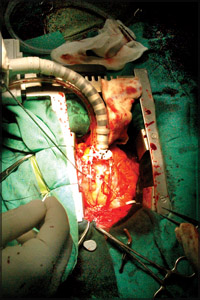 |
|
A clear view of stabilising
the heart for grafting a vein. |
Some of the muscles may not recover. Better to do it before the
damage occurs. That is why we advice patients who have to be watchful
about symptoms and those who have strong family history of heart
failures and are suffering from risk factors, to seek immediate medical
advice rather than waiting until the heart gets weaker and weaker.
A patient with a one block can go for angioplasty that is stenting.
But in cases where there is a block but stanching cannot be done because
the block is severe and close to the main artillery, they need by pass
surgery”, Dr. Lahie enlightens us during the job .
Stitches are put to the six inch vein where there is a possibility of
bleeding. Then the coronary artillery opened and the graft put on to the
opening while the ‘blow mister’ is sucking whatever blood is collected
in the ‘compartment’.
The surgeons say that lifestyle changes. Stress and less exercises
led more young males and females in their 30s to get coronary artillery
blocks. This life saving effort needs a good medical team including good
anaesthetic and as these surgeons stress the surgeons alone cannot bring
good results in heart operations.
One stich in a wrong place can make a big difference. No short cuts
here and artilleries on which the whole heart depends are measured in
millimetres. The patients’ chest is covered with an antibiotic layer and
a single grafting will take 45 minutes.
Now the surgeons are trying to mimic the nature. The heart is lifted
and it is back in the compartment. The graft that is put into the
artilleries will put into the ayota, which is the main blood supply to
the entire body.
The blood is gushing heavily from the tiny hole cut in the ayota. It
will do enough to bathe the whole ceiling. Now the beating heart surgery
is nearing completion where the left arteria descending artillery is
bypassed to the left internal mammary artillery, and the vein is grafted
to the top end of the ayoto and the distil end to the circumflex and
right coronary.
After three and half hours long highly delicate surgery, a tiny drop
of blood is not wasted. Instead, the surgeons are able to save one to
three pints of blood which will be given to the patient once she in this
case is transferred to the Intensive care unit in the next few minutes.
Burnt
The remaining places which are leaking blood are burnt with electric
current and two tubes are inserted to drain the remaining blood after
the surgery.
Now the fine work is finished and the surgeons start fixing the
strong bone using stainless steel wires, which will last till the
patient dies.
“She will go home within ten days; but”, cautions Dr. Lahie, “she has
to take extra care about her food; needs to follow the doctor’s advice”.
Putting the final stich on the chest of the patient will not end the
‘medical drama’. It will continue until he or she regains consciousness.
Until then the medical staff is too breathless. For it is a tough
session which decides a life.
In this hi-tech era, an alternative fluid for human blood is yet to
be tapped. It is miraculous that the surgeons too ‘go green’ by
recycling and re-using human blood.
Pix by Wimal Karunatilake
|
